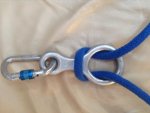Oscarpop
New member
A couple of years ago, following a thread on here about diy boom brakes, I purchased a climbing figure of 8.
It's about 6 inches long in old money.
I was going to rig it to use as a boom brake. Hang it just aft of the rigid kicker. One line from the chain plate, through the figure of 8 ( as shown in the picture), then through a block by the other chainplate, led back to a clutch in the cockpit. I figure that this is the same tensioner as some of the other devices on the market, works on friction , however it cost a damn site less.
Is this a dumb idea? I don't want to be reliant on someone that is dangerous.
Ideas and suggestions please.

Yacht is 40ft and med displacement
It's about 6 inches long in old money.
I was going to rig it to use as a boom brake. Hang it just aft of the rigid kicker. One line from the chain plate, through the figure of 8 ( as shown in the picture), then through a block by the other chainplate, led back to a clutch in the cockpit. I figure that this is the same tensioner as some of the other devices on the market, works on friction , however it cost a damn site less.
Is this a dumb idea? I don't want to be reliant on someone that is dangerous.
Ideas and suggestions please.

Yacht is 40ft and med displacement
Last edited:
